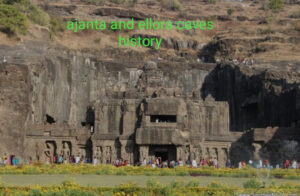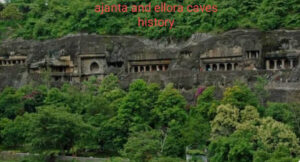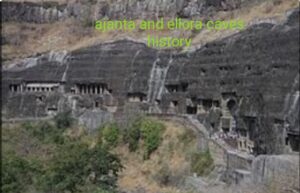Nestled in the heart of Maharashtra, India, the Ajanta and Ellora Caves History stand as magnificent testaments to the rich cultural and historical tapestry of ancient India. These rock-cut wonders, carved meticulously into the cliffs, have captivated historians, archaeologists, and travelers alike. As UNESCO World Heritage Sites, the caves offer a glimpse into the artistic and religious fervor that flourished from the 2nd century BCE to the 10th century CE. This blog delves into the intriguing history and unparalleled artistic grandeur of the Ajanta and Ellora Caves.

1.Overview of Ajanta and Ellora Caves History
Located near the city of Aurangabad, the Ajanta and Ellora Caves are among the most significant historical sites in India. Ajanta, famous for its Buddhist cave monuments, is situated approximately 100 kilometers from Ellora, which houses an array of Buddhist, Hindu, and Jain caves. Together, they showcase the pinnacle of ancient Indian rock-cut architecture and artistry.
2. Ajanta and Ellora Caves History : Historical Background
The discovery of these caves was nothing short of serendipitous. Ajanta Caves were discovered in 1819 by a British officer during a hunting expedition, while Ellora’s fame predates modern historical records. The construction of Ajanta Caves began around the 2nd century BCE, reaching its zenith during the Gupta period. Ellora Caves, on the other hand, were carved between the 5th and 10th centuries CE, under the patronage of the Rashtrakuta dynasty. These caves served as monasteries, chapels, and temples, providing refuge to monks and pilgrims.

3. Ajanta and Ellora Caves: Ajanta Caves
Ajanta comprises 30 caves, each a marvel of intricate artistry and architectural genius. These caves are renowned for their stunning frescoes and murals, which vividly depict the life of the Buddha and various Jataka tales. The paintings in Cave 1 and Cave 2 are particularly noteworthy for their vibrant colors and detailed expressions.
• Notable Caves at Ajanta
– Cave 1 : Famous for its elaborate carvings and well-preserved paintings that illustrate the past lives of Buddha.
– Cave 2 : Known for its beautiful murals and detailed ceiling paintings.
– Cave 16 : Highlights the grandeur of the Vakataka period with its exquisite sculptures and intricate carvings.
4.Ajanta and Ellora Caves: Ellora Caves
Ellora, with its 34 caves, represents a confluence of three major religions: Buddhism, Hinduism, and Jainism. The site is an epitome of rock-cut architecture, with each cave bearing unique artistic and religious elements.
• Notable Caves at Ellora
– Cave 10 (Vishvakarma Cave) : A Buddhist cave, also known as the Carpenter’s Cave, is renowned for its grand chaitya hall.
– Cave 15 (Dashavatara Cave): A Hindu cave dedicated to Vishnu, showcasing intricate sculptures and carvings.
– Kailasa Temple (Cave 16): The crowning glory of Ellora, this monolithic structure dedicated to Lord Shiva is an architectural marvel, larger than the Parthenon in Athens.

5. Artistic and Cultural Significance
The Ajanta and Ellora Caves are not just historical sites; they are treasure troves of ancient Indian art and culture. The caves reflect the zenith of Indian artistic skills, from the delicate frescoes of Ajanta to the monumental rock-cut sculptures of Ellora. These artworks have significantly influenced subsequent Indian art forms and architectural styles.
6.Modern-Day Relevance
Today, Ajanta and Ellora Caves attract millions of tourists, scholars, and art enthusiasts from around the world. These sites not only boost the local economy but also foster a deep appreciation for India’s cultural heritage. Efforts by the Archaeological Survey of India and UNESCO have ensured the preservation and conservation of these priceless monuments.
Conclusion:
The Ajanta and Ellora Caves are enduring legacies of India’s historical and cultural grandeur. They offer an unparalleled journey through ancient times, reflecting the artistic and religious spirit of their creators. Visiting these caves is akin to stepping back in time, experiencing the splendor and spirituality that shaped India’s heritage. We invite you to explore these magnificent caves and witness the timeless beauty etched in stone.
FAQ:
1.What is the history of Ellora cave?
2.What is the difference between Ellora and Ajanta Caves?
3.Who was the founder of the Ajanta Caves?
4.What is the historical significance of Ajanta Caves?
5.Ajanta and ellora caves history wikipedia
6.Ajanta and ellora caves history pdf
7.Who built Ajanta and Ellora caves
8.Ajanta and ellora caves history in english
9.Ajanta and ellora caves history in urdu
10.10 lines on Ajanta Caves in English


Pingback: Daulatabad Fort Aurangabad : The Best Architectural Marvel Through the Ages - solotraveler